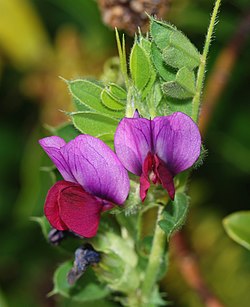| Fabeae | |
|---|---|
 | |
| Vicia sativa | |
| Scientific classification | |
| Kingdom: | Plantae |
| Clade: | Tracheophytes |
| Clade: | Angiosperms |
| Clade: | Eudicots |
| Clade: | Rosids |
| Order: | Fabales |
| Family: | Fabaceae |
| Subfamily: | Faboideae |
| Clade: | Meso-Papilionoideae |
| Clade: | Non-protein amino acid-accumulating clade |
| Clade: | Hologalegina |
| Clade: | Inverted repeat-lacking clade |
| Tribe: | Fabeae Rchb. |
| Synonyms | |
| |
The tribe Fabeae (sometimes referred to as "Vicieae") [1] is one of the subdivisions of the plant family Fabaceae. It is included within the Inverted repeat-lacking clade (IRLC). [2] Four genera are included: [1] [3]